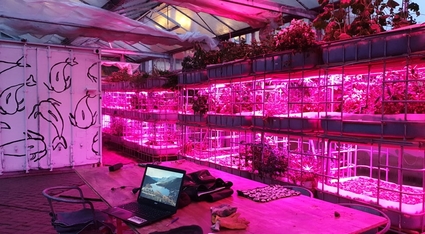It's December 18th, 2019, three days away from the shortest day of the year. Winter time is here, which means colder nights and less sunshine. What's the effect of the winter season on our aquaponics system and how can we prepare and manage to ensure a productive system? Are there enough nitrogen nutrients entering the system for the plants?
In order to answer this question, it's important to consider the main processes which ensure the success of nitrogen cycling in our system. These are fish feeding, urination and defecation, bacteria nitrification, and plant biofiltration.
Our African catfish provide nitrogen in the form of ammonia in the water when they excrete waste after feeding. Fish metabolism can be slowed when water temperatures drop. Biological processes are slowed and the fish may refuse to eat and have reduced appetites. In such a case, less ammonia is provided for bacteria to transform into nitrates for plant uptake.
Although African catfish are opportunistic species, meaning they readily adapt feeding habits to their environmental context, when temperatures drop well below their optimum range feeding is likely negatively affected.
Fish are cold-blooded animals, meaning they do not regulate their body temperature at a constant level, but instead are dependent on external temperatures. As a result, it is vital to regularly test ammonia, nitrate, and nitrate levels in the water to ensure adequate nitrogen availability for the plants. Feed volume should be adjusted accordingly. If levels of NH3/4 are too high or too low, you may need to reduce the amount of feed provided. Since biofiltration and nitrogen uptake by plants is greatly reduced in colder winter temperatures, reduced fish feeding may be necessary to avoid ammonia poisoning. Warning signs of ammonia poisoning include if the fish are gasping for air and yellowing (chlorosis) between the veins in the leaves of the plants.
Additionally, we must consistently monitor the temperature of the fish tanks. We currently use 1000W rods to heat the fish tanks, and have temperature sensors which record the tank temperatures and are connected to a digital display by the entrance.
The optimal water temperature range for African catfish in aquaponics is 18-32oC, below which metabolism and feeding may be lowered to a point which provides insufficient nutrients for the plants. We don't want to overfeed the fish, especially in winter, but also want to ensure enough nitrogen circulates in the system. Our tank temperatures remain at a comfortable 19-21oC with the help of the heating rods. It's important, especially during winter, to keep an eye on the electronic temperature readings to the right of the container to notice any drastic drops in temperature. It is important to check and ensure that the sensors and the heating rods are functioning properly. If there is a fault in the tank heating system, this must be fixed immediately (article link: https://www.mediamatic.net/en/page/368086/fixing-aquaponics). It's also vital for the container doors to remain closed unless you need to be inside.
In principal, the amount of food fed to the fish does not need to be altered seasonally, especially true for a heated indoor aquaponics system as we have, as long as the water temperature for the fish remains in a comfortable range. Additionally to the temperature, the fish behavioral response to feeding is monitored and recorded on a scale of 5-1, based on levels of enthusiasm when being fed. A behavioral response of 3 and above is OK. It is a concern if the response is below a '3'. In such a case feeding should be lowered and the fish closely monitored for any other issues (i.e. dead fish, change in color etc.). In the winter it's also particularly vital to check whether there are any food pellets leftover when feeding. If so, the fish may have reduced appetites or metabolisms, and feeding amounts may have to be decreased.
Not only are the metabolic rates of the catfish affected by temperature, but so is that of the nitrifying bacteria. Both have optimal temperatures at which they best carry out biological processes of feeding and nitrifying. Nitrification is the process by which ammonia/um is converted into nitrites and nitrates (see equation below).
2NH3+ + 3O2 --> 2NO2 + 2H+ + 2H2O
Ammonia --> nitrite
2NH4+ + 4O2 --> 2NO3 + 4H+ + 2H2O
Ammonium --> nitrate
The optimum temperature range for nitrifying bacteria is higher, between 25 and 30oC, than that of the African catfish. Nitrification is particularly reduced in efficiency below 18oC. In the winter there is therefore a risk that while the fish may be metabolizing the food pellets, temperatures may be too cold for the nitrifying bacteria to convert the ammonia to nitrite and ammonium to nitrates. High levels of ammonia can be toxic and lead to ammonia poisoning.
Given the above and the things to be weary about during the colder months, I will monitor the situation in our aquaponics system carefully and write an updated article.
